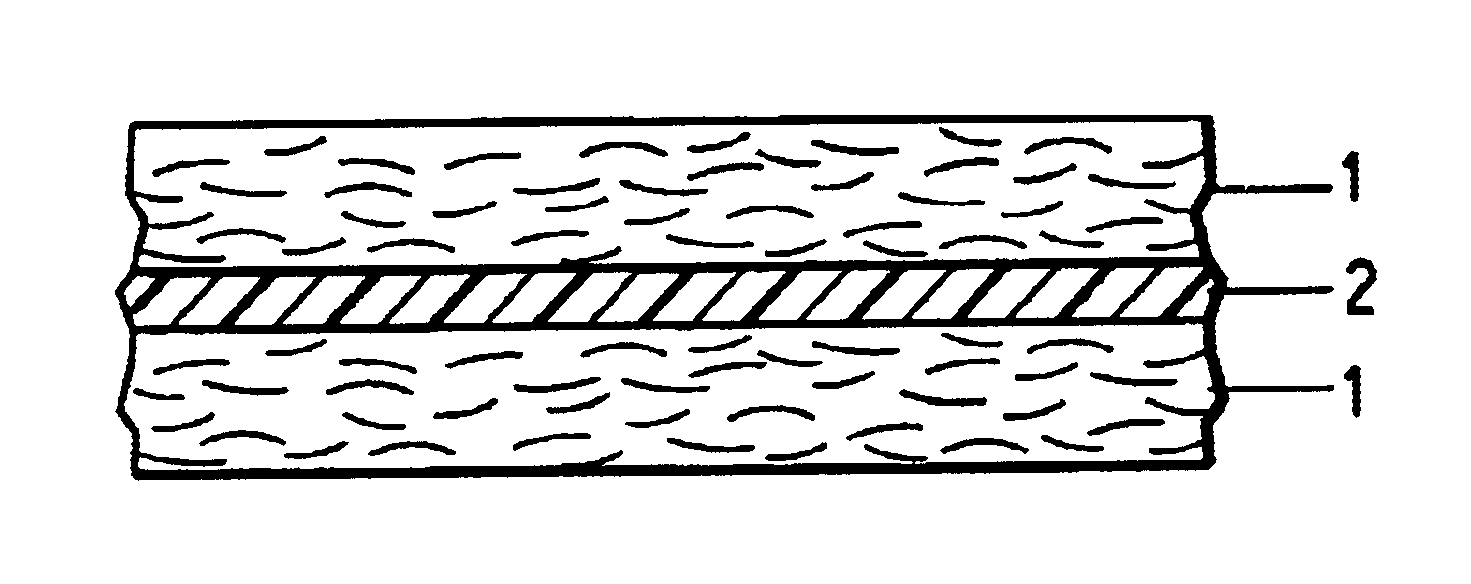Sheet material especially useful for circuit boards
a technology of circuit board and sheet material, applied in the field of sheets, can solve the problems of aramid fibers, epoxy resins, and fibers such as aramid fibers, and is unsuitable for use together in highly demanding circuit board uses
- Summary
- Abstract
- Description
- Claims
- Application Information
AI Technical Summary
Benefits of technology
Problems solved by technology
Method used
Image
Examples
example 1
[0072]A multilayer structure of:[0073](1) As-formed paper (68 g / m2 basis weight) made from 87% by weight poly(p-phenylene terephthalamide) floc (2.25 denier per filament, 6.7 mm cut length) and 13% by weight poly(m-phenylene isophthalamide) fibrids.[0074](2) A 56 μm thick film of LCP. The film had a basis weight of 78 g / m2.[0075](3) Same as layer 2[0076](4) Same as layer 1.
was prepared [layers (1) and (4) formed the outer surfaces] and passed through a 76.2 cm diameter roll calender at 305 linear cm / minute with the rolls at 350° C. and at a pressure of 263 kN / m of width. The resulting sheet was densified and bonded together. Photomicrographs showed that the LCP layers had flowed into the aramid paper layers, penetrating almost to the outer surfaces but leaving a small quantity of the LCP resin in the middle of the structure. There was no evidence of displacement of the p-aramid fibers by the penetrating resin. The product had a basis weight of 254 g / m2, was 292 μm thick, and an appa...
example 2
[0078]LCP blown film (with nominal thickness of 30 μm and average basis weight of 41 g / m2) was laminated between two layers of formed paper (same as Layer 1 in Example 1 with basis weight of 31 g / m2) under following conditions in a vacuum press:[0079](a) held in vacuum (no external pressure or temperature).[0080](b) Heated to 320° C. (5° C. / min) from ambient condition under a pressure of 6.9 MPa.[0081](c) Held for 1 h at 320° C. and 6.9 MPa.[0082](d) Cooled to rapidly room temperature (water quench) under pressure.
[0083]Laminates were produced with average dimension of 25 cm×20 cm×185 μm and average weight of 4.7 g (basis weight 100 g / m2). The laminates were approximately 60% paper aramid and 40% LCP.
[0084]The laminates from made above were prepregged with a commercial multi-functional epoxy using standard techniques known in the industry. The resulting three component composite (paper+LCP film+epoxy) was 235 μm thick with an average epoxy content of 46% by weight of the total lamin...
example 3
[0098]LCP blown film (with nominal thickness of 30 μm and average basis weight of 41 g / m2) was laminated between two layers of calendered paper (same as layer 1 of Example 1, with basis weight of 31 g / m2) under following conditions in a vacuum press:[0099](a) Held in vacuum (no external pressure or temperature).[0100](b) Heated to 320° C. (5° C. / min) from ambient temperature under a pressure of 6.9 MPa.[0101](c) Held for 1 h at 320° C. and 6.9 MPa.[0102](d) Cooled to room temperature fast (water quench) under pressure.
[0103]Laminates were produced with average dimension of 25 cm×20 cm×90 μm and average weight of 4.6 g (basis weight 94 g / m2). The laminates were approximately 60% aramid and 40% LCP.
[0104]The laminates were prepregged with commercial multi-functional epoxy as in Example 2. The resulting three component composite (aramid+LCP film+epoxy) was 150 μm thick with an average epoxy content of 25% by weight of the total laminate. The final laminate had approximately 45% aramid,...
PUM
| Property | Measurement | Unit |
|---|---|---|
| length/width | aaaaa | aaaaa |
| diameter | aaaaa | aaaaa |
| aspect ratio | aaaaa | aaaaa |
Abstract
Description
Claims
Application Information
 Login to View More
Login to View More - R&D
- Intellectual Property
- Life Sciences
- Materials
- Tech Scout
- Unparalleled Data Quality
- Higher Quality Content
- 60% Fewer Hallucinations
Browse by: Latest US Patents, China's latest patents, Technical Efficacy Thesaurus, Application Domain, Technology Topic, Popular Technical Reports.
© 2025 PatSnap. All rights reserved.Legal|Privacy policy|Modern Slavery Act Transparency Statement|Sitemap|About US| Contact US: help@patsnap.com


